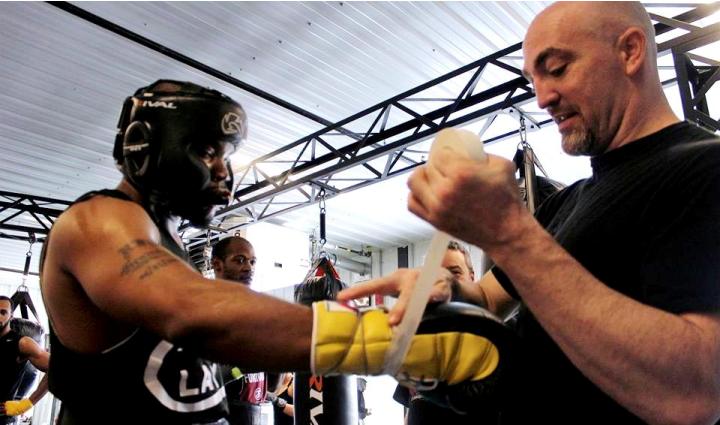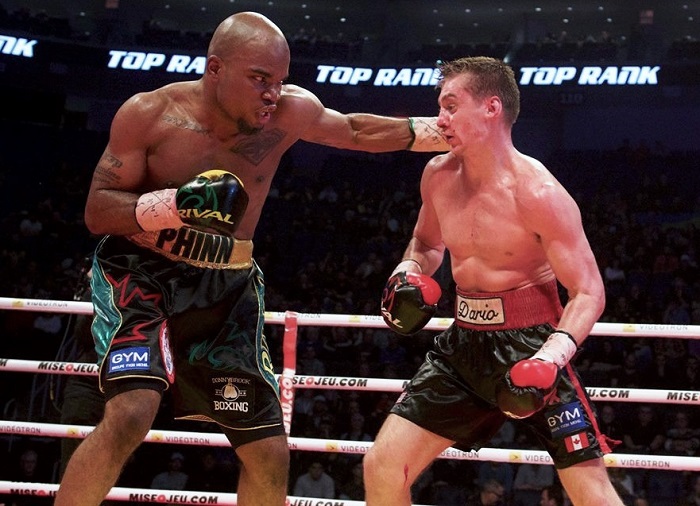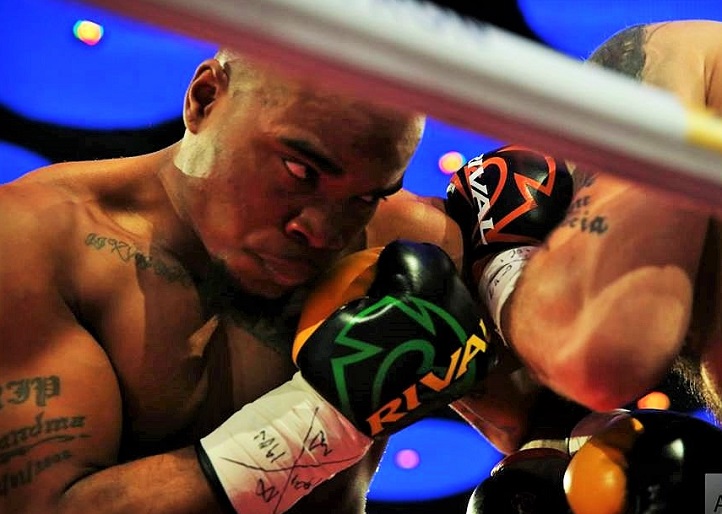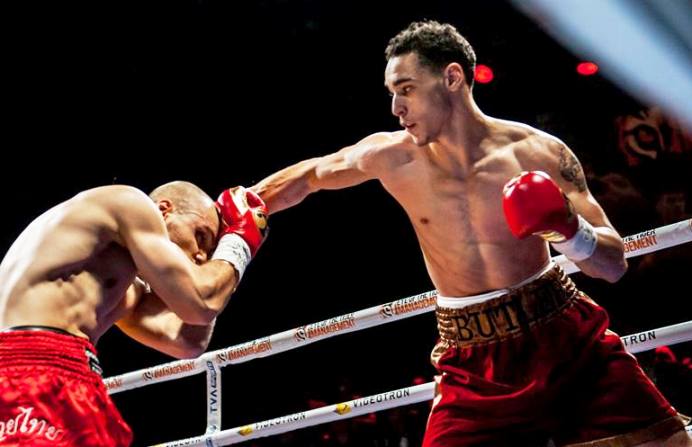Back In The Win Column
As chronicled in detail on this website, the boxing journey of Ian MacKillop is a unique story unto itself as he has truly led a fighter’s life, traveling all over the world, training with Freddie Roach and Vernon Forrest, and trading leather with tough customers like Kermit Cintron, Daniel Geale and Shannon Taylor. Now he passes on his hard-won knowledge at the Donnybrook Boxing Gym on Rue Brock and while he trains a number of aspiring pugilists, his primary focus is one Shakeel Phinn, a super middleweight contender who was the main event performer on the latest edition of Groupe Yvon Michel’s casino cards.

However, Phinn was supposed to be the warm-up act, so to speak, as the scheduled main attraction at the Montreal Casino’s Cabaret Room had in fact been undefeated Marie-Eve Dicaire (14-0) who was set to defend her super welterweight titles, but her opponent, one Lina Tejada (12-5) of the Dominican Republic, failed to pass the pre-fight medical and the main event bout had to be scrapped. But if some Montreal fans were disappointed at the last minute cancellation, others took interest in what was an important rebound match for Phinn, one of the city’s most promising boxers. Indeed, in MacKillop’s opinion, Saturday’s bout was a crucial test for his fighter.
“This was definitely a significant fight,” he told this writer when asked to reflect on the outcome. “For me, Shak needed to up his game, because he was coming off a draw in his last outing. No shame in having a tough fight against Dario Bredicean; he’s undefeated and a good boxer. But I wasn’t happy with Shak’s performance at all that night.”

The Bredicean vs Phinn tilt had been part of the undercard for December’s memorable Adonis Stevenson vs Oleksandr Gvozdyk title match in Quebec City, after which Stevenson suffered a career-ending brain injury. And while it wasn’t televised, the Shak vs Dario match-up did attract attention from local fight fans as it was a rare showdown between two talented Montreal-based prospects. The bout proved a highly competitive and tactical affair with two of the three judges scoring it dead even, and the third giving it to Phinn by a wide margin. While MacKillop, not surprisingly, thought Shakeel did enough to win, he was not at all satisfied with his charge’s showing.
“That was not even close to the best Shak,” says MacKillop. “So from my perspective, he had something to prove on Saturday. I wanted to see what I didn’t see against Bredicean.”
But did Juan Carlos Raygosa, a journeyman with a 12-14-3 record, represent the kind of competition by which anyone could accurately assess Phinn’s performance? Was he anything other than a “stay busy” opponent?

“Raygosa is much better than his record indicates,” says MacKillop. “He can box and he’s experienced. In fact, in his last fight in July he took on Tim Cronin of Ontario, the Canadian light heavyweight champ. Fought him in Belleville, Ontario and the bout was a draw, but when a guy gets a draw in the other guy’s hometown, you know what the deal is. And before that, Raygosa had been in with some really good boxers and no one had stopped him in like six years, so we knew we couldn’t take him lightly. We formulated a solid game plan and this time Shak stayed focused and executed it perfectly.”
Clearly, in MacKillop’s view, staying focused and executing the prescribed strategy was not the story of the Phinn vs Bredicean match.
“I shouldn’t be too hard on Shak,” says the trainer. “The fact is, world-class boxers start when they’re very young, but he’s only been boxing for like eight years, so taking that into account, he’s actually ahead of schedule. I mean, successful fighters start when they’re 12 or 13, but Shak was almost 20 when he got serious about boxing. So he’s able to do what he does because he’s a gifted athlete and very smart, but he’s really only at about seventy percent of where he could be. He just needs more experience and that was obvious with Bredicean, where he didn’t stay focused the way he needed to.”

Focus, in MacKillop’s view, is what’s needed in order to bypass competitive distance fights decided by scorecards that may or may not be accurate, and get what the trainer really wants: knockouts. After all, with 14 KO’s to his credit, Shak has shown he’s got the strength and power required to hurt men and put them down. So Saturday’s result was satisfying for Ian not only because his fighter followed the game plan, but because in round five the tough and experienced Raygosa hit the canvas and then decided to stay there.
“Shak did exactly what I wanted him to do,” says Ian. “He kept throwing the heavy shots to the body and broke the guy down. The key is the body attack. Moving forward, it’s going to be extremely difficult for anyone at 168 to stand up to Shak’s body punches.”
The other components of the game plan involved head movement, level changes, and throwing plenty of jabs. And then having the patience to let the punishment to the belly and ribs accrue over time, though some in attendance at the Montreal Casino didn’t see the need for such patience.

“It was funny,” says MacKillop, “but after the fight more than one person was like, ‘What was wrong? Is Shak okay? Why did he start so slow?’ Meanwhile, I was super happy. He did exactly what I wanted him to do. He followed the plan and systematically broke the guy down. Maybe he could have ended it a bit earlier, but in my opinion it’s better for a developing fighter to follow the game plan and develop that patience and mental discipline.”
And with that important rebound win under his belt, Shakeel is back in the win column as he turns his attention to the next challenge, one already set for him, and arguably his toughest yet. Once again the site will be the Montreal Casino, but in June, during the big Grand Prix weekend, and the opponent will be a capable fighter who also boasts a knockout over Juan Carlos Raygosa. Bruno Sandoval is 20-3-1 with 16 KO’s and has held WBC and USNBC titles. He and Shak will battle for the IBF International super middleweight belt, the winner to take home both the strap and a guaranteed top 15 world ranking. It’s a major challenge, but MacKillop is confident his fighter will rise to it.

“Everything is in place for Shak. He’s always in great condition and he’s put together a very respectable record. He’s signed with Yvon Michel and we have excellent sparring here, and I mean truly world-class sparring. Everyone likes Shak and we can go anywhere in Montreal and get work. He gets rounds in with people like David Lemieux, Steven Butler, Christian Mbilli. You can’t get better work than that.”
And if Ian can be a demanding trainer, it’s primarily because he can see Shak’s tremendous potential. Phinn’s career mark of 20-2-1 reflects the fact there’s been some bumps in the road, but for MacKillop that’s all to the good as they forced his young fighter to become even more serious and committed.

“He’s learned some lessons and he understands better how the boxing business really works. If you’re going to be successful, you have to be totally dedicated; you can never get comfortable, never be complacent. And I see it in the gym; Shak just keeps getting sharper. And one of the things I really like is that, as good as he competes in sparring, he raises his game in the ring, which is the opposite of a lot of boxers. And honestly, he’s only going to get better. Because while most fighters have one or two dangerous weapons to rely on, Shak has a full tool set. He’s still learning, still a work-in-progress, but now he has a truly world-class jab, a terrific right hand, and a dangerous uppercut. So when he puts it all together, he’s going to be extremely hard to beat. He’s just got too many weapons.”
And no one should overlook the key weapon that decided the Raygosa fight, namely a special talent for rifling agonizing, will-sapping blows to an opponent’s vitals. A hard truth for all boxers is you can be in optimal condition and do a million sit-ups, but nothing will make your liver, kidneys and stomach less vulnerable.
“His body attack is lethal,” says MacKillop. “I think that’s what’s going to make him a world champion. It’s a real gift: he’s a truly devastating body puncher. That’s probably his most dangerous weapon and we’re just really sharpening it up now. He’s always had the power, but now he’s really honing the technique and that, combined with his head movement and the fact it’s so hard to catch him clean as he’s coming at you … he’s just a very dangerous fighter for anyone at 168.”

So how do you know for certain a boxer has had a truly outstanding performance in a given fight? One that reflects all the hard work in the gym and bodes well for the future? You don’t listen to the fans, or the back-slappers, the promoters or the pundits. You listen to the trainer. And according to this coach, Shakeel Phinn is ready for his big test come the eighth of June in Montreal.
“I was super happy. He’s finding his identity as a fighter. And he’s got the full toolkit now. Everything is in place and we’re ready for the next challenge.”
— Michael Carbert





